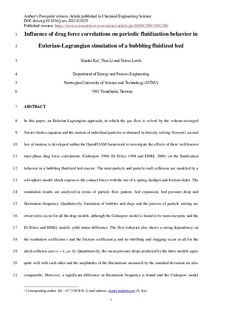| dc.contributor.author | Ku, Xiaoke | |
| dc.contributor.author | Li, Tian | |
| dc.contributor.author | Løvås, Terese | |
| dc.date.accessioned | 2019-02-25T10:27:02Z | |
| dc.date.available | 2019-02-25T10:27:02Z | |
| dc.date.created | 2013-04-17T16:26:05Z | |
| dc.date.issued | 2013 | |
| dc.identifier.citation | Chemical Engineering Science. 2013, 95 94-106. | nb_NO |
| dc.identifier.issn | 0009-2509 | |
| dc.identifier.uri | http://hdl.handle.net/11250/2587188 | |
| dc.description.abstract | In this paper, an Eulerian–Lagrangian approach, in which the gas flow is solved by the volume-averaged Navier–Stokes equation and the motion of individual particles is obtained by directly solving Newton's second law of motion, is developed within the OpenFOAM framework to investigate the effects of three well-known inter-phase drag force correlations (Gidaspow, 1994, Di Felice, 1994 and EHKL, 2006) on the fluidization behavior in a bubbling fluidized bed reactor. The inter-particle and particle–wall collisions are modeled by a soft-sphere model which expresses the contact forces with the use of a spring, dashpot and friction slider. The simulation results are analyzed in terms of particle flow pattern, bed expansion, bed pressure drop and fluctuation frequency. Qualitatively, formation of bubbles and slugs and the process of particle mixing are observed to occur for all the drag models, although the Gidaspow model is found to be most energetic and the Di Felice and EHKL models yield minor difference. The flow behavior also shows a strong dependency on the restitution coefficient e and the friction coefficient μ and no bubbling and slugging occur at all for the ideal-collision case (e=1, μ=0). Quantitatively, the mean pressure drops predicted by the three models agree quite well with each other and the amplitudes of the fluctuations measured by the standard deviation are also comparable. However, a significant difference in fluctuation frequency is found and the Gidaspow model predicts a lowest fluctuation frequency whereas the Di Felice model gets a highest one. Finally, effects of the spring stiffness and the discontinuity in the Gidaspow model are studied. The results show that both mean bed pressure drop and fluctuation frequency slightly decrease as the spring stiffness increases for all the three drag models and no significant differences are observed in the mean bed pressure drop and fluctuation frequency between the Gidaspow model and the linear continuous model. | nb_NO |
| dc.language.iso | eng | nb_NO |
| dc.publisher | Elsevier | nb_NO |
| dc.rights | Attribution-NonCommercial-NoDerivatives 4.0 Internasjonal | * |
| dc.rights.uri | http://creativecommons.org/licenses/by-nc-nd/4.0/deed.no | * |
| dc.title | Influence of drag force correlations on periodic fluidization behavior in Eulerian-Lagrangian simulation of a bubbling fluidized bed | nb_NO |
| dc.type | Journal article | nb_NO |
| dc.type | Peer reviewed | nb_NO |
| dc.description.version | acceptedVersion | nb_NO |
| dc.source.pagenumber | 94-106 | nb_NO |
| dc.source.volume | 95 | nb_NO |
| dc.source.journal | Chemical Engineering Science | nb_NO |
| dc.identifier.doi | 10.1016/j.ces.2013.03.038 | |
| dc.identifier.cristin | 1024367 | |
| dc.relation.project | Norges forskningsråd: 193817 | nb_NO |
| dc.description.localcode | © 2018. This is the authors’ accepted and refereed manuscript to the article. This manuscript version is made available under the CC-BY-NC-ND 4.0 license http://creativecommons.org/licenses/by-nc-nd/4.0/ | nb_NO |
| cristin.unitcode | 194,64,25,0 | |
| cristin.unitname | Institutt for energi- og prosessteknikk | |
| cristin.ispublished | true | |
| cristin.fulltext | postprint | |
| cristin.qualitycode | 2 | |

